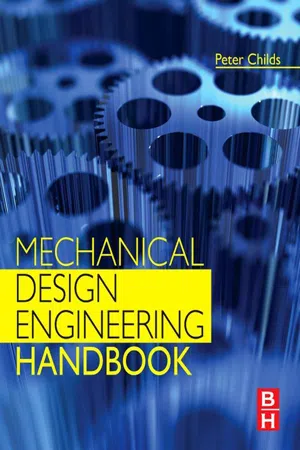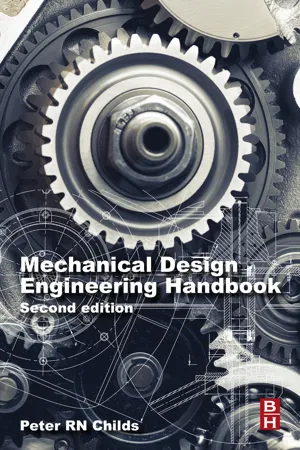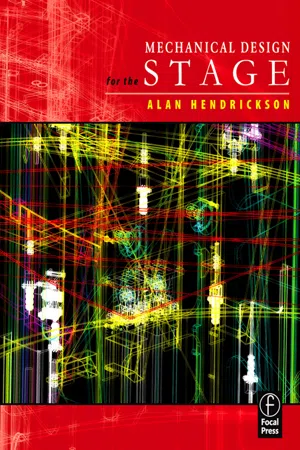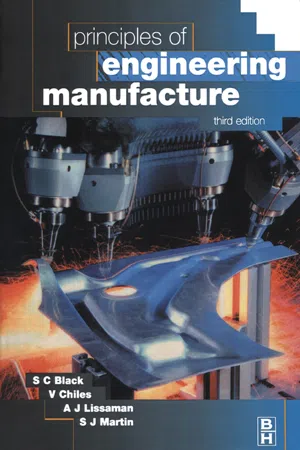Technology & Engineering
Frames and Machines
Frames and machines are essential components in engineering and technology. Frames are structures composed of interconnected members, while machines are devices that transmit and modify forces to perform work. Understanding the principles of frames and machines is crucial for designing and analyzing various mechanical systems and structures.
Written by Perlego with AI-assistance
Related key terms
Related key terms
1 of 4
Related key terms
1 of 3
4 Key excerpts on "Frames and Machines"
- eBook - ePub
- Peter Childs(Author)
- 2013(Publication Date)
- Butterworth-Heinemann(Publisher)
Figure 4.11 illustrates this point in that access for doors, windows, and occupants must be provided.Figure 4.11 Bus frame design.Allin and Simon (2002) .Some of the more important design parameters to consider for an enclosure or frame include: strength, size, assembly, appearance, corrosion resistance, stiffness, vibration, weight, noise, production costs, maintenance costs, and sustainability. A list such as this may be too all-encompassing to be of much use at the start of a design process. The following list of factors may be more helpful to consider as the onset for a frame or enclosure:• Forces exerted by the machine components through mounting points such as bearings, pivots, brackets, and feet, • Requirements to support the frame itself, • Allowable deflections of constituent machine elements, • Cooling requirements, • Environments into which the machine will be transported and installed in relationship to other machines and infrastructure, • Quantity required, • Production facilities available, and • Expertise available for the design task.The complexity involved when considering more that one machine element is evident. Due to the need to “keep the bigger picture in mind,” models for the design process such as total design are useful.4.11 Conclusions
The technology base available to us includes a wide range of machine elements such as bearings, shafts, gears, chains, belts, seals, clutches, brakes, and fasteners. This chapter has served to introduce these items, many of which are available as stock items from specialist manufacturers. This means that the tasks of the designer become that of selecting and specifying the appropriate item, which eliminates the task of the detailed design of, for instance, a roller chain. Subsequently, greater focus can be applied to the design of the overall machine. - eBook - ePub
- Peter Childs(Author)
- 2018(Publication Date)
- Butterworth-Heinemann(Publisher)
Fig. 4.17 illustrates this point, in that, access for doors, windows and occupants must be provided.Fig. 4.17 Bus frame design (Allin and Simon, 2002 ).Some of the more important design parameters to consider for an enclosure or frame include the following: strength, size, assembly, appearance, corrosion resistance, stiffness, vibration, weight, noise, cost to produce and maintain, and life. A list such as this may be too all-embracing to be of much use at the start of a design process and a more helpful list of factors to consider as the starting point for a frame or enclosure include the following:- • forces exerted by the machine components through mounting points such as bearings, pivots, brackets and feet;
- • how the frame itself will be supported;
- • allowable deflections of constituent machine elements;
- • cooling requirements;
- • the environments into which the machine will be transported and installed and the relationship to other machines and infrastructure;
- • the quantity required and production facilities available and
- • the expertise available for the design task.
The complexity involved when considering more than one machine element is evident and because of the need to keep the bigger picture in mind, models for the design process such as total design are useful.4.11 Conclusions
The technology base available to us includes a wide range of machine elements such as bearings, shafts, gears, chains, belts, seals, clutches, brakes and fasteners. This chapter has served to introduce these items, many of which are available as stock items from specialist manufacturers. This means that the designer's task becomes that of selecting and specifying the appropriate item and relieves him or her of the task of the detailed design of for instance a roller chain so the design of the overall machine can be concentrated on. - eBook - ePub
- Alan Hendrickson(Author)
- 2012(Publication Date)
- Routledge(Publisher)
23 Frames and Framing
DOI: 10.4324/9780080557540-23General Concepts
While the frame surrounding and supporting stage machinery components seems to be simple, just a box or plate to hold the working elements in their proper alignment, it should be given the same careful consideration as the rest of the machine. The design of the frame can easily determine whether the whole machine is effective and elegant, or awkward and nearly unusable. The frame affects the machine’s ease of assembly, how it is handled and transported from shop to stage, how quickly it loads in as part of the effect it runs, how well it accommodates the adjustments and maintenance needed during tech and run, and the safety of technicians and performers who work around it.Open vs. Enclosed Frames
One of the first decisions to make is how extensive a frame is desired. The frame can fully enclose all components, to protect them in transport or to prevent injury to those nearby during operation, or the frame can be as simple as a mounting plate which connects the machine to the deck or grid and is open on all other sides. In general, the more enclosed concept is recommended, since it gives greater protection to both the machine and personnel, and, if designed well, can allow multiple lifting points and different mounting configurations. When designing an enclosed frame, the designer must envision the assembly of both the frame itself and the components to be mounted within it. Some questions to keep in mind when designing for fabrication and assembly are: - eBook - ePub
- V. Chiles, S. Black, A. Lissaman, S. Martin(Authors)
- 1996(Publication Date)
- Butterworth-Heinemann(Publisher)
6Mechanics of Machine Tools
6.1 Basic features of a machine tool
A machine tool provides the means for cutting tools to shape a workpiece to required dimensions; the machine supports the tool and the workpiece in a controlled relationship through the functioning of its basic members, which are as follows:1. Bed, structure or frame. This is the main member which provides a basis for and a connection between the spindles and slides; the distortion and vibration under load must be kept to a minimum.2. Slides and slideways. The translation of a machine element (e.g. the slide) is normally achieved by straight-line motion under the constraint of accurate guiding surfaces (the slideway).3. Spindles and bearings. Angular displacements take place about an axis of rotation; the position of this axis must be constant within extremely fine limits in machine tools, and is ensured by the provision of precision spindles and bearings.4. Power unit. The electric motor is the universally adopted power unit for machine tools. By suitably positioning individual motors belt and gear drives are reduced to a minimum.6.2 Forces in a machine tool
Stresses which tend to deform the machine tool or workpiece are caused by the following:1. Static loads i.e. the weight of the machine and its various parts as considered on p. 148 .2. Dynamic loads, i.e. forces induced by rotating or reciprocating masses.
Index pages curate the most relevant extracts from our library of academic textbooks. They’ve been created using an in-house natural language model (NLM), each adding context and meaning to key research topics.
Explore more topic indexes
Explore more topic indexes
1 of 6
Explore more topic indexes
1 of 4



